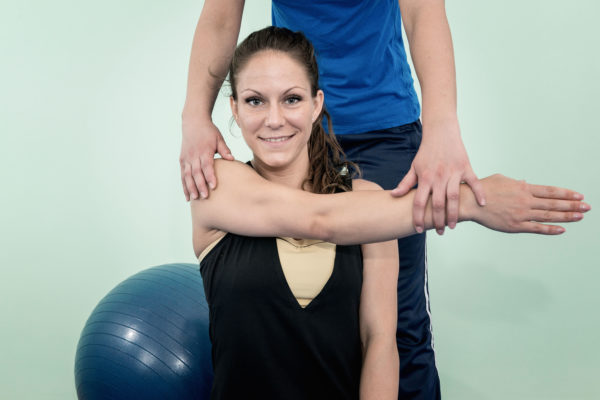Rotator cuff tears are extremely common, especially as we grow older. Up to 30% of the population over the age of 60 have at least a partial rotator cuff tear. In fact, they are so common that many people disregard or are unaware of the symptoms and don’t even realize they have one.
Frequently we hear about rotator cuff tears in connection with baseball players, rowers, swimmers and other athletes.
But did you know that this condition is also common in people who perform repetitive overhead motions or lifting, such as painters, or carpenters?
The risk of a torn rotator cuff also increases with age, because we just start to wear out. If you have been experiencing shoulder pain, you may have a rotator cuff tear. Your shoulder pain may be caused by trauma, an injury, repetitive motions or it may be simply a result of aging.
What is the rotator cuff?
First, it helps to understand just what the rotator cuff is. It consists of a group of four tendons and muscles in the shoulder. These muscles and tendons connect the upper arm to the shoulder-blade. The tendons provide stability to the shoulder and the muscles allow the shoulder to rotate. Damage to your rotator cuff can cause limited range of motion, weakness and pain.
Top 2 Causes of Rotator Cuff Tears
There are two main causes of rotator cuff tears — injury or degeneration.
- If you fall and injure your shoulder, or try to break your fall with your arm, or lift a heavy object with a jerking motion, you may have a sudden, or acute tear.
- Rotor cuff degeneration occurs when the muscles and tendons wear down over time. Repetitive stress from sports, a job (especially one that requires lifting your arms over your head), or even certain routine chores can cause overuse tears. In addition, as we age, the blood supply to the rotator cuff decreases. Therefore, the body is less able to repair tendon damage naturally. Bone spurs are another effect of aging which leads to shoulder impingement and gradually weakens the tendons.
Common Symptoms
Common symptoms of rotator cuff tears include:
- Pain in the shoulder and arm. The pain is commonly located over the outside of the shoulder and upper arm.
- Tenderness and weakness in the shoulder.
- You may have trouble moving your shoulder, particularly when you are lifting your arm above your head or holding your arm directly out from your body.
- Some people find it difficult to go to sleep on the affected shoulder, or pain may awaken them throughout the night.
- People who have a rotator cuff tear may have difficulty combing their hair, getting dressed, or doing other activities that require reaching behind their back.
- Another warning sign is snapping and crackling sounds when moving the shoulder.
Here’s how to test your shoulder (videos)
Your physical therapist can test the strength of your rotator cuff tendons and establish the extent of the tear.
- Which tendon is the most commonly torn? Find out in this video I recorded for people who signed up for our workshop.
- What grade is the tear? Learn the 3 grades of tears in this video.
- When diagnosing a rotator cuff tear, the doctor may also order an MRI, which can identify both complete and partial rotator cuff tears.
- Warming up before any vigorous activity is essential. Your warm up should include stretching your arms and shoulders.
- When exercising, use small, controlled movements. Using less resistance with more repetitions will help strengthen the shoulder muscles and reduce the risk of injury.
- Resting your shoulders before and during a workout or other vigorous activity can relieve stress on the rotator cuff.
- If you have had a rotator cuff injury, frequent stretches as well as messages and cold and hot compresses can relieve mild pain and inflammation.
Reducing your risk
While rotator cuff tears are common, there are steps you can take to reduce the risk or to keep a previously injured shoulder pain-free and functional.
Treatment
The goal of treatment is to reduce pain and restore strength and function to the shoulder.
Treatment for rotator cuff tears can be either surgical or nonsurgical, depending on a number of factors. These include:
- The nature and severity of the tear.
- The functional damage
- The individual’s regular activity level.
Depending on the nature and severity of your rotator cuff tear, treatment may include:
- Medication
- Corticosteroid injections
- Rest
- Physical therapy
- Possibly surgery.
Many patients work with a physical therapist to restore strength and motion. A physical therapist can design an individualized treatment plan of exercises, stretches and techniques improve your mobility without putting too much stress on injured muscles and tendons.
If you think you may have a rotator cuff tear, don’t ignore the problem — seek help. If you have an injury to your shoulder and it is very painful, or you cannot move your shoulder normally, seek medical attention immediately. Or if you have had a shoulder problem in the past or home treatment and self-care is not working, call your physical therapist. Rotator cuff tears are frequent, but they are treatable. Seeking treatment will help you minimize or eliminate pain and engage in the activities you love. Generally, the best results occur when the tear is treated sooner rather than later.
Our locations:
- Kennedy: (412)-771-1055
- Crafton: (412)-458-3445
- Allison Park: (412)-487-2787
- Bethel Park: (412) 835-2626
- Atlasburg: (724) 947-9999
Website: www.hesspt.com
Disclaimer: this information is "not medical advice" and is used at the site visitor's own risk.
Yours in good health,
George Hess

